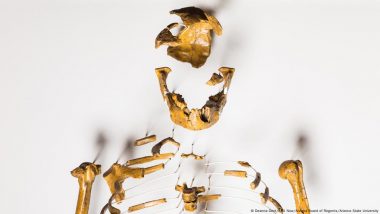The discovery of a Lucy, a 3.2 million-year-old skeleton changed our theory of human evolution forever. The discovery is celebrating its 50-year anniversary, continues to capture human imagination.You've seen it before. The chart of an ape walking on all fours, shedding its hair, standing upright, grabbing a spear and growing taller to become a modern human.
This diagram called 'The March of Progress' simplifies evolution into a series of stages which took place over millions of years.
The thinking of early theorists was that our evolution was a coordinated, linear process. Our ancestors' brains grew steadily larger as they started walking on two legs and standing taller until they became modern human — Homo sapiens.
This is still a commonly used depiction of human evolution, with the famous Progress diagram having been published in a book called "Early Man" in 1965 explaining how we grew from apes to modern humans.
But this oversimplified view of human evolution is not quite right, and was upended in 1974 after the discovery of a 3.2 million-year-old skeleton called Lucy.
New ideas about evolution thanks to a knee bone
When paleoanthropologist Donald Johanson first found the skeleton in a remote region of Ethiopia in 1974, the bones seemed unremarkable.
But one bone in the collection — the knee — changed our idea of human evolution forever.
The knee bone was more similar to that of a modern human, rather than any older specimens. As Johanson tells it, this stronger-legged species had evolved in such a way that its legs were capable of supporting its upper body weight.
"It really showed us without a doubt that the skeleton was, like the knee, fully upright — walking like we do," Johanson told DW.
And yet Lucy still had a small brain.
This was curious because it was thought at the time that modern humans would have evolved bigger brains and the ability to walk upright simultaenously.
"Even Darwin, way back in the 1870s, said that this is one of the cardinal features of being human. But it [Lucy] had a very small brain, so it solidified the argument that upright walking appeared in our ancestry before we saw large brains," Johanson said.
In other words, Lucy's strong knees and small skull showed our ancestors didn't learn to carve tools or walk upright the moment our brains got big. Instead, they likely learned to walk before higher intelligence came along.
Human evolution is like a bushy tree or a braided river
Lucy's discovery didn't just revise one of Darwin's ideas. It was the first of many fossils to reinforce the complex nature of evolution itself — the 'March of Progress' is inaccurate.
A better way to think about human evolution is like a 'bushy tree' with many branches. This is the metaphor increasingly used by scientists in this field.
Each branch represents an individual human species. Some species grow and evolve or time. Other branches get trimmed off as the species dies off.
In our case, Homo sapiens has persisted long enough to dominate the planet.
Andy Herries, a paleoanthropologist at La Trobe University, Melbourne, Australia, prefers the concept of a 'braided river' to a bushy tree, but the principle is essentially the same.
"[Evolution] is not a case of a species evolving into something else and then that original species going extinct. It's really about thinking about populations," said Herries.
Maybe a species continues to evolve by gaining new traits, say Homo erectus evolves into Homo sapiens.
Or maybe they interbreed with other species — like humans did with neanderthals.
Or they could die out completely, like our doomed cousins Homo floresiensis, which inhabited a tiny Indonesian island 50,000 years ago before going extinct.
"A population of Homo erectus can evolve into something else, whereas a population in Indonesia may stay pretty much as it is if it doesn't have any particular selective pressures on it.
"Those populations split apart, but then also combine again, which is why it's really like a braided river,” said Herries.
There are still missing links to find
Lucy's unique body shape led to the classification of entirely new species of early human. Lucy's kind are now called Australopithecus afarensis, in honor of the Ethiopian region's Afar people, where she was discovered.
Lucy's species probably wasn't a direct predecessor to modern humans, but it could be one of many options.
The discovery of different early human species which existed around the same time — around 3 million years ago — has added other evidence to the tree-theory of human evolution.
There are still missing links in the evolution of modern humans, but as more hominin fossils are found, our understanding of the pathway to our species will be gradually filled in.
"As new information comes in, we have to fold in that information to create a fuller and more comprehensive understanding of our ideas," Johanson said.
As for Lucy's legacy, her discovery is now like a mascot for evolution. It was a flashy finding which, along with lots of other data, helped develop a better theory of how our species came to be.
"Back in the 70s, when Lucy was found, it was such a singular discovery. It is probably the most recognized specimen [and] the name has always helped in that regard, because everyone remembers it," Herries said.
Edited by: Fred Schwaller
(The above story first appeared on LatestLY on Nov 21, 2024 06:30 PM IST. For more news and updates on politics, world, sports, entertainment and lifestyle, log on to our website latestly.com).













 Quickly
Quickly












